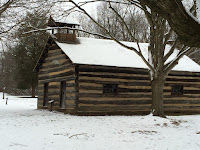Christmas at Schoenbrunn in 1773
by Tamera Lynn Kraft
 |
| Schoenbrunn Village |
The missionaries, both white and native families moved from a town in Pennsylvania called Bethlehem. Moravians had come to Bethlehem years earlier when a preacher named John Wesley had donated the land to them. But the Lenape had been forced west as more white men had moved into the area, so the Moravians decided to move west with them.
Life was hard in Schoenbrunn. Cabins were quickly made and community gardens were planted that included beans, corn, and squash. Most villages also planted potatoes and turnips next to their cabins. The rest of their food came from hunting. But the real danger came from the many Indian tribes surrounding the village, some of them hostile.
 |
| Schoenbrunn School |
The village council was led by David Zeisberger and including white Moravians and Lenape converts. The rules for the village were established by the Lenape Christians. These missionaries did not consider the native converts to be beneath them but instead brothers in Christ.
 |
| Fireplace in Schoenbrunn Church |
In every home in Schoenbrunn, families decorated artificial Christmas trees with candles and papers with scriptures written on them. The trees were made by putting together a wood frame and decorating it with real pine branches. The family would also make a putz, a nativity village that included the nativity scene, the wise men, and other Biblical scenes and place it under the tree. Most Moravians gave small gifts at Christmas, but resources were so limited that the children in Schoenbrunn were happy with their candles they received at the church. After a Christmas feast, the family would read the verses hung on the tree and talk about God’s blessings at Christmas.
Schoenbrunn Village has been restored and is open to tourists.
Find out more at this link (http://www.ohiosfirstvillage.com) .
A Christmas Promise
By Tamera Lynn Kraft
A Moravian Holiday Story, Circa 1773
During
colonial times, John and Anna settle in an Ohio village to become Moravian
missionaries to the Lenape. When John is called away to help at another
settlement two days before Christmas, he promises he’ll be back by Christmas
Day.
When
he doesn’t show up, Anna works hard to not fear the worst while she provides
her children with a traditional Moravian Christmas.
Through
it all, she discovers a Christmas promise that will give her the peace she
craves.
“Revel
in the spirit of a Colonial Christmas with this achingly tender love story that
will warm both your heart and your faith. With rich historical detail and
characters who live and breathe on the page, Tamera Lynn Kraft has penned a
haunting tale of Moravian missionaries who selflessly bring the promise of
Christ to the Lenape Indians. A beautiful way to set your season aglow, A
Christmas Promise is truly a promise kept for a heartwarming holiday tale.” –
Julie Lessman


Thank you Tamera for sharing this. I love learning new things about our country's history. Your book, A Christmas Promise sounds very good.
ReplyDeleteBlessings, Tina
Thanks, Tina.
DeleteThanks for this informative article, Tamera! I really enjoyed learning about the Christmas Eve traditions practiced at Schoenbrunn Village as well as the details about their Christmas trees. Merry Christmas!
ReplyDeleteThanks, Cynthia. Merry Christmas.
Delete